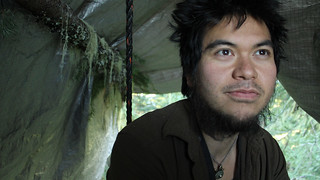Stationed on wooden platforms and rope lines 100 feet in the air, members of the group Cascadia Forest Defenders are protesting what they claim is a clear cut of native forest. The logging is part of a pilot project designed to mimic nature. | credit: Amelia Templeton | rollover image for more
MYRTLE CREEK, Ore. — Last year, the U.S. Bureau of Land Management sold the rights to log a small grove of Douglas firs to a private company called Roseburg Forest Products.
Roseburg bid more than $1 million for the trees, and planned to start logging this fall.
Then the tree sitters showed up.
Stationed on wooden platforms and rope lines 100 feet in the air, members of the group Cascadia Forest Defenders are protesting what they claim is a clear cut of native forest. But the scheduled logging is also part of a pilot project designed by Northwest forestry professors to mimic nature.
The professors’ plan has become politically popular and is a key component of bills proposing new management for Oregon’s O&C Lands — a checkerboard of parcels in Western Oregon named for the Oregon & California Railroad that once owned them. Those on both sides of the protest say it’s potentially the first battle in the next big debate over how to manage Northwest forests.
The site in question, known as the White Castle timber sale, lies about 19 miles east of Myrtle Creek, at the end of a narrow gravel road curving up a forested ridgeline and covered with ice, boulders and fallen trees. The forest here started growing 120 years ago after a fire burned through this area, west of Crater Lake. It’s native forest, never been cut before, but it’s not “old growth” forest.
“When I first got here, I was so excited that I spent a good week or two, just in the tree. It’s wonderful,” said Josh Eng, a 29-year-old with a pointy, black beard who has spent much of the past nine weeks living on one of the tiny platforms.
 Josh Eng. Credit: Amelia Templeton
Josh Eng. Credit: Amelia Templeton.
Eng, taking his turn stationed in the tree, answers to the nickname Turtle when fellow protesters shout up to him from the ground camp. That camp includes a tent, a kerosene lamp, and a milk crate full of science fiction novels from the Eugene Public library.
“The books are extremely important because we have minimal entertainment out here except for ourselves,” protester Brian Garcia said.
To reach Turtle and the heart of the group’s tree camp requires buckling into a climbing harness and using sliding knots called prusiks to climb inchworm-style up 100 feet of rope.
The wooden platform at the top is just big enough to sleep on. Buckets of food and water hang from the branches nearby. It rocks gently like a boat as the top of the fir tree sways in the wind.
“Yes, always keep connected. Two points of safety,” Eng said. He remains clipped in, even while he sleeps.
Watch: Tree Sitter Josh Eng Climbs To A Platform
This high up, Eng figures he’ll be very difficult to arrest. So far, he says, nobody’s tried to remove him from the tree. Or, rather, no people have tried to remove him.
“I do have a squirrel that kind of comes around at night, and yells at me and throws things,” Eng said.
Eng’s arch nemesis in this conflict, apart from the squirrel, isn’t necessarily Roseburg Forest Products, or even the BLM. It’s a pair of forestry professors: Norm Johnson at Oregon State University and Jerry Franklin at the University of Washington. The two have a long track record in conservation.
Kate Armstrong, a 21-year-old University of Oregon student and part of the protest, said they see the pilot project as a clear cut under the guise of science.
“I think that it’s a shame that they would call themselves scientists and call themselves conservationists or environmentalists who care about the forest, but who would put their names on such a bogus project that is so obviously to me just playing into what the logging industry wants to have happen,” Armstrong said of Johnson and Franklin.
 Norm Johnson. Credit: Amelia Templeton
Norm Johnson. Credit: Amelia Templeton.
Johnson, who said he knew White Castle would be controversial the minute he set foot there, has visited the protesters and said he’s taking their comments to heart.
“I could see how disappointed they were in me,” Johnson said. “Yeah, that’s hard.”
Johnson said this timber sale isn’t your grandfather’s clear-cut. The pilot project is a demonstration of something called a “variable retention harvest.”
“The approach we’re taking is trying as best we can to emulate the development of a wild forest,” he said. “We’re not trying to replace it with a tree farm. ”
Several years ago, U.S. Secretary of the Interior Ken Salazar asked Johnson and Franklin to help the BLM develop timber harvests that would be profitable while serving an environmental purpose. The professors drew inspiration from a wealth of new research, published in the years after the Mount St. Helens eruption, on the importance of so-called early seral habitat that develops after natural disasters like eruptions, windstorms and large wildfires.
In the variable retention harvest Johnson and Franklin developed, the largest, oldest trees on a site don’t get cut down. About a third of the standing and fallen wood is left untouched, while the rest gets logged. The site is largely allowed to recover naturally, with foresters replanting a minimal amount of species like fir, cedar, and hemlock. After a few years, a meadow of grasses and bushes and berries will start to grow in place of the forest.
“There are many creatures that like to live in openings. Say mountain bluebirds, or salamanders,” Johnson said.
This moment just after the destruction of a forest, when young trees compete with bushes and grasses for sun is called an early seral ecosystem. It can last for 30 years or more, until the conifers grow tall enough to block the light. Studies show as much of 35 percent of the landscape in the western Cascades used to be early seral habitat, but that’s now fallen to as little as 2 percent.
“The diverse early seral stage is actually rarer than old growth right now,” Johnson said. “We are very short of it.”
Johnson and Franklin’s idea: mimic nature, and create a few more rural jobs in the process, has proved popular with politicians. Oregon Senator Ron Wyden has introduced a bill that would use Johnson’s technique to significantly increase the amount of timber cut on public lands in Western Oregon.
“We worked with the best scientists in the Northwest to make these harvests as ecologically friendly as we possibly could,” Wyden said in a recent press conference.

Near White Castle timber sale on O&C Lands east of Roseburg, Ore. Credit: Amelia Templeton.
Johnson calls the harvest rate set in Wyden’s bill modest, allowing logging on 2 or 3 percent of the 2.6 million acres of the BLM’s O&C lands in the first decade. He says logged areas would be given roughly 100 years to grow back into forest.
“I would be less comfortable with it if the harvest rate was much higher,” Johnson said.
But the Cascadia Forest Defenders are not alone in criticizing the idea.
“Jobs, logs and early seral forest can all be attained without wrecking more mature forests,” Doug Heiken of Oregon Wild wrote in comments submitted to the BLM. “There is 20+ years of young stand thinning to do and significant new reasons NOT to conduct (regeneration) harvest in mature forests.”
Trees older than 80 years contain clearer wood of a higher value, though, said Scott Folk, Vice President of Resources at Roseburg Forest Products, which can be used in a wider variety of higher grade products.
The U.S. Bureau of Land Management says moving forward with the logging pilot project is critical. And it is in the process of closing road access to the ridgeline to try to force the tree sitters to move on.
“We want to be respectful of the protesters, and respectful of their right to protest the sale,” said Steve Lydic, Field Manager with the BLM in Roseburg. “But there comes a time when the timber sale purchaser also has the right to harvest wood they have purchased.”
Back on the ridge east of Roseburg, tree sitter Josh Eng says the fact that logging here could become a blueprint for other harvests on public lands makes him all the more determined to stop it.
“This is a very beautiful place. And it would be a real heartbreaking thing to see it go the way of a variable retention harvest,” Eng said.
© 2013 OPB
















